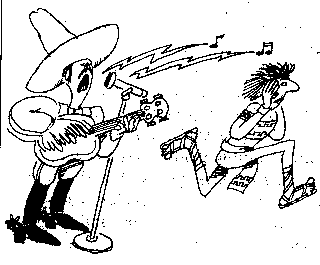History of
Mexico --- I
& L. Milam
 Mexico was invented many years ago by the Toltecs, Mixtecs, Med-Tecs, Hi-tecs, and Lo-Tecs. These ancient peoples were obsessed by time, and built many pyramids so they could look at it. They also devised calendars which enabled them to predict with remarkable accuracy the timing of comets, eclipses, and long holiday weekends.
Mexico was invented many years ago by the Toltecs, Mixtecs, Med-Tecs, Hi-tecs, and Lo-Tecs. These ancient peoples were obsessed by time, and built many pyramids so they could look at it. They also devised calendars which enabled them to predict with remarkable accuracy the timing of comets, eclipses, and long holiday weekends.The next civilization to appear in Mexico was the Aztecs. These people made pyramids and indecipherable calendars too, but they had a dark side: they invented the marimba and, as if that were not enough, they practiced blood sacrifice. First, throngs of Aztec priests would work themselves into a frenzy by playing "Cielito Lindo" over and over again on their marimbas. Then, the head priest would place a young man on a stone calendar and eat his heart out. It was a sight to curdle the blood. The priests wore black vestibules and skin shirts and had greasy locks. They dominated Aztec society in the time of its last god-king, Quacktemoc.
About the same time, Herman Cortex arrived from Toledo, Spain with his mounted band called the Conquistadors. He landed on the coast and soon enough heard about Acapulco Gold which made him very greedy. He and the Conquistadors and their horses marched on the Aztec capital to meet Quacktemoc. On the way, Cortex dallied with a native woman named Malpractice, who became the expedition's lead singer.
In his capitol, Quacktemoc and a vast crowd of Aztecs with their greasy locks and marimbas awaited the legendary visitors from across the sea. When the Spaniards finally arrived in Mexico City, they were astonished by its canals, its beautiful floating gardens, and its municipal bus system which carried many more people than the buses in Toledo or Akron. Quacktemoc was astonished by his visitors' ability to speak Spanish without having to consult their Berlitz phrase books. The Aztecs, too, were astonished by the Spaniards' guns, their amplified electric guitars, and the fact that they could sing and play while riding horseback. The horses, too, were astonished by the Spaniards' awful lyrics, and one night they bolted. This was later referred to as "La Noche Triste."
Although the Spaniards were outnumbered 100 to 1, their sound system easily drowned out their opponents' marimbas, and the Aztecs fled in disarray. Quacktemoc was left a helpless prisoner of the Spaniards, and they forced him to listen to their lyrics until he begged for mercy and offered to fill the entire hall with Acapulco Gold. Overcome with gratitude, Cortex converted the Aztec king to Christianity on the spot, and then garroted him. After this, the Aztecs revolted, but it was too late, and Cortex and his band conquered all of Mexico from Gotamala in the south, Walla Walla to the north, and as far east as Atchison, Topeka and Santa Fe.
Mexican history disappears soon after only to reappear about 1812 with the "Frito de Dolores." Dolores worked as a housekeeper for kindly Father Hígado, and she entered history by complaining about the Spanish food, which she called revolting. Soon all the pheasants in Mexico were revolting over the food. Incensed, the Spanish authorities grilled the pheasants and fried kindly old Father Hígado. His martyrdom is still remembered in much of Mexico with fireworks, vacations, and revolting food.
Americans and Mexicans came together sometime in the 1850's when Santy Anna overcharged us at The Alamo, a clip-joint in Texas (or Tejas, as it was then called). This is now remembered in the U.S. with parties, vacations, and revolting food too. "Remember the Alamo" is in memory of where they all died with their boots on, except for General Custard, who wore bunny wabbit slippers.
In reprisal, the U.S. took over Missouri, Texas, Arizona, California, New Mexico, Nevada, Colorado, and much of Weehauken, N. J. This was ratified by the Continental Congress as the Missouri Compromise. Around 1854, the U. S. noticed that a bit of Arizona called Godsent had been overlooked, and purchased it with a Federal Visa card. The U. S. paid Mexico seventy-five million pesos for Godsent, which made Mexico feel better. This was before the last devaluation of the peso, so the final cost of the territory came to well over $23.
A Guide for Puzzled Mexicans
©1997, Mho & Mho Works